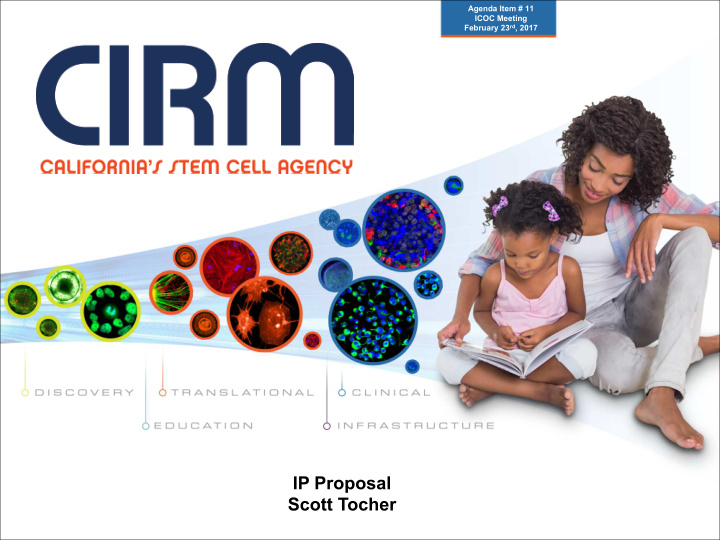



Agenda Item # 11 ICOC Meeting February 23 rd , 2017 IP Proposal Scott Tocher
MISSION Our Mission To accelerate stem cell treatments to patients with unmet medical needs. 2
History I. CIRM IP DNA and Evolution Proposition 71: Seeing the forest for the trees § Proposition 71 requires the Board to strike a balance between the opportunity for the State to benefit from licensing revenues/royalties and the need to ensure the regulations do not unreasonably hinder essential research and therapy development. 3
Current II. Summary of Existing Regulations 1. CIRM does not own any inventions 2. Grantees must undertake reasonable efforts to bring inventions and technologies (including data) to practical use 3. There is no obligation to publish, but in most instances, material must be made available for Cal. Research 4. Financial obligations exist through revenue sharing, access and pricing regulations 4
Current III. Existing Licensing Revenue Math Licensing Revenue Proportionality Reduction Calculation: If, during the project period, CIRM funds 50% or more of the CIRM § funded project that gives rise to the CIRM Funded Invention or Technology, CIRM licensing revenue share = 25% § If CIRM funds less than 50%, licensing revenue share = 15% Effectively only applies to non-profit awardees because of § exception for upfronts/milestone payments received by for-profit 5
Current III. Existing NCR Math Royalty on Net Commercial Revenue (NCR) § 0.1% per $1 million in grant, for the earlier of ten (10) years or 9x the grant amount § Where project includes patent covering CIRM Funded Invention and CIRM grants equal or exceed $5M, 1% royalty on NCR in excess of $500M/year, until the last to expire patent covering a CIRM Funded Invention § Only applies to awards to for-profit entities 6
IV. Goals for IP Revisions § Ensure regulations are clear and self-executing § Fundamental components should be objective instead of subjective § Revenue sharing should be easy to calculate so that awardees have certainty about their obligations § Administrative efforts should support CIRM’s strategic mission, not interpreting and enforcing rules 7
V. Need for IP Reform LACK OF ALIGNMENT § Obligations follow licenses - some awardees don’t license data; § CIRM Funded Technology (data) made available to commercial partner with no benefit back to CA if made “publicly available.” § Conflicting views of meaning of “reasonable efforts” to negotiate license agreements. 8
V. Need for IP Reform LICENSING REVENUE CHALLENGES § Revenue calculation depends on extent of third parties’ financial contributions, which can be difficult to calculate. § Definition of “licensing revenue” for for-profits excludes upfront/milestone payments prior to commercialization – different for non-profits. § Interpretation and application of rules can yield different conclusions, creating uncertainty regarding an awardee’s obligations. 9
V. Need for IP Reform ADMINISTRATIVE BURDEN IS SIGNIFICANT § Rules are not self-executing; require subjective determination. § Subjective determination creates two risks: (1) uncertain obligations; and (2) inconsistent application of rules. § Pre-award review of MTA/license agreements may cause project delay. 10
V. Need for IP Reform DISPARATE TREATMENT OF AWARDEES § No rationale for disparate treatment of awardees based on profit status. § If Big Pharma licenses a CIRM project from non-profit and commercializes it, Big Pharma pays nothing to the state (non-profit is required to share a portion of its licensing revenues). But if Big Pharma licenses a CIRM project from a small biotech, it is required to share revenue equal to 0.1%/$million of CIRM awards, capped at 9x grant amount, with the state. 11
VI. Solution: 2.0 our IP Regulations Solution: 1. Treat non-profit and for-profit awardees the same 2. Focus revenue sharing obligation on successful products and therapies – apply the ”Commercializing Entity” concept to all awardees and reach through to those drugs and therapies that make “regulatory use” of CIRM-funded technologies (e.g., IND-enabling data and clinical data) 3. Retain Access & Pricing Provisions 12
VI. Solution: 2.0 our IP Regulations These revisions: § Reconnect regulatory scheme to fundamental tenets § Strike Prop 71’s balance to share revenue but not hinder research/commercialization § Optimize CIRM’s resources = focus on strategic plan goals § Simplify revenue sharing = easier to understand, explain, and apply § Focus revenue sharing on market successes 13
Requested Action § The IP & Industry Subcommittee unanimously recommends the ICOC initiate the rulemaking process to adopt new regulations. § The regulatory process is anticipated to take 6-9 months. § The new policy would apply to new awards and allow existing awardees to opt in. § We seek ICOC approval to begin the process to adopt the new policy. 14
MISSION Our Mission Accelerating stem cell treatments to patients with unmet medical needs. 15
Recommend
More recommend